Hello Prof @stream4u, thank you for the lectures about pivot point. It is really an addition to my knowledge of indicators. Below is my homework post.

Source
Pivot Point
Pivot points is a tool that is used to indicate the change in market movements and also to determine the trends at different time intervals.
Intraday traders use this tool as a guide as to when to enter into a trade, to know where to place a stop loss, when to take profit and most times to know when there is reversal in the market trend.
Pivot points takes into consideration the relationship between the previous day’s high, the previous day’s low and the previous day’s closing price. This information are very important as they are used in calculating pivot points. The calculations are then used to determine the support and resistance level in the market bear and bull oscillations.
As a thumb rule, whenever the market movement is above the pivot point, traders interpret it as a bullish market and whenever the market goes below the pivot point, traders interpret it as bearish market.

Details about Pivot Point Levels
Prof. @stream4u in his lecture post mentioned that pivot points are calculated using information of the high, low, and close levels of the previous trading session. This helps to determine the resistance which is at the top and the support below the market trend.
So on the pivot point level, there are resistance levels labeled as R1, R2, R3…. Etc. also, there are support levels below the Resistance and they are labeled S1, S2, S3…..etc.
But between the resistance and support levels lies the Base pivot point. See screenshot below.
| Pivot Point Levels | Details |
|---|---|
| Main Pivot Level (PP) | it is the central pivot level on the chart and also the main pivot point on the chart. |
| Resistance 1 (R1) | it is the very first pivot level seen above the main pivot level |
| Resistance 2 (R2) | it is the second pivot level seen above the main pivot level and above R1 |
| Resistance 3 (R3) | it is the third pivot level seen above the main pivot level and above R2 |
| Resistance 4 (R4) | it is the fourth pivot level seen above the main pivot level and above R3 |
| Resistance 5 (R4) | it is the fifth pivot level seen above the main pivot level and above R4 |
| Support 1 (S1) | It is the first pivot level directly below the main pivot level |
| Support 2 (S2) | it is the second pivot level below the main pivot level and below S1 |
| Support 3 (3) | it is the third pivot level below the mian pivot level and below S2 |
| Support (4) | it is the fourth pivot level below the main pivot level and below S3 |
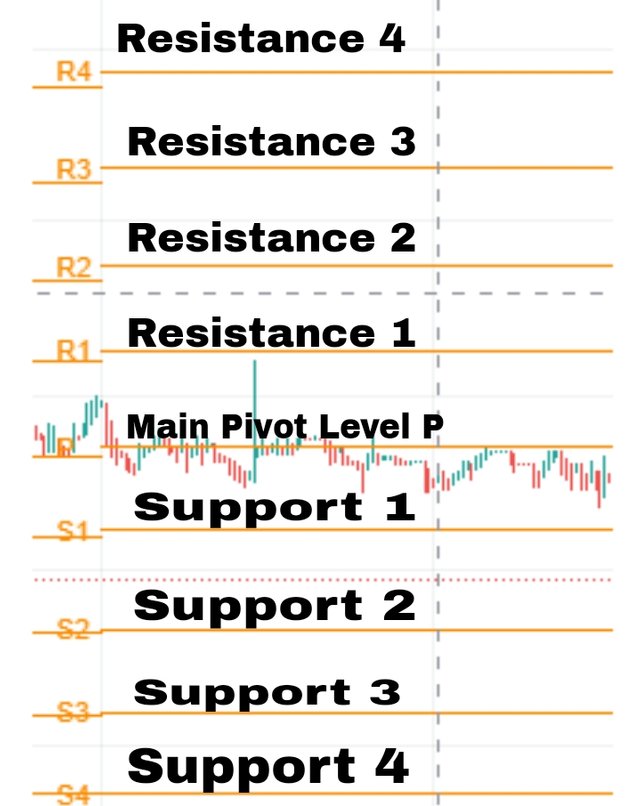

Pivot Point Calculation and R1, R2, S1, S2 Pivot Levels Calculation
The same method used in calculating pivot point of a previous day is used to calculate for the previous week or previous month.
Main Pivot PP = (Daly High + Daily Low + Close)/3
R1 = (PP x 2) – Daily Low
R2 = (PP + Daily High – Daily Low)
S1 = (PP x 2) – Daily High
S2 = (PP – Daily High – Daily Low)

How To Apply Pivot Point On Chart
I will be demonstrating how to apply Pivot Point on the chart of STEMBTC using TradingView .
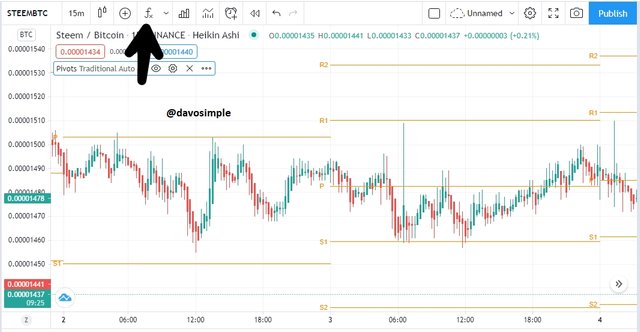
On the chart of STEEMBTC, I will using the 15 minutes candle duration. Then I will click fx indicators
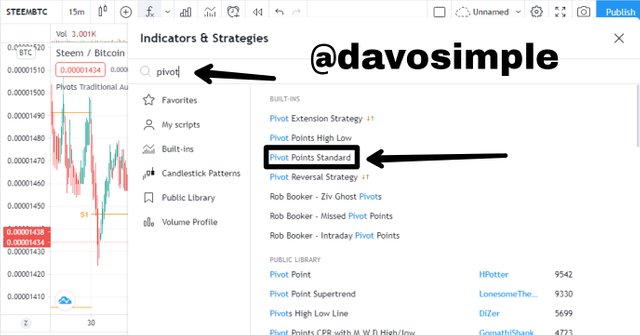
And then search for pivot point. Different results will pop up, then I will chose the Pivot Point Standard
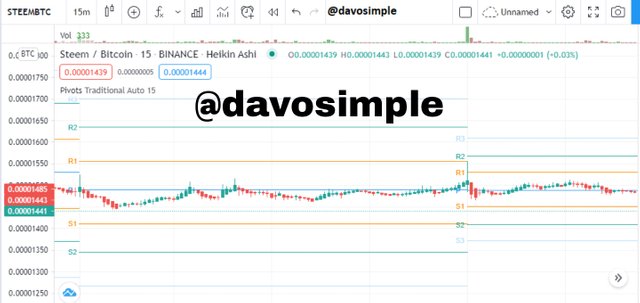
Here is the different pivot point levels added to my chart.
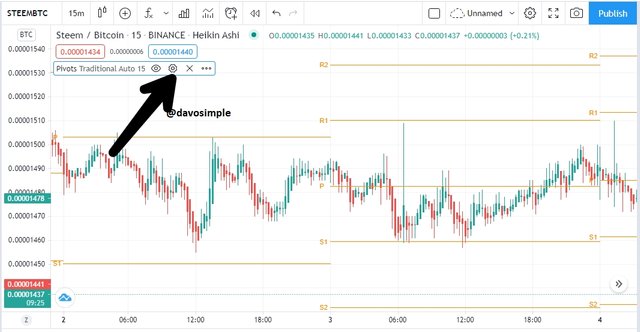
I will have to configure the chart to how I want it to be to so I will click on the settings icon as shown above
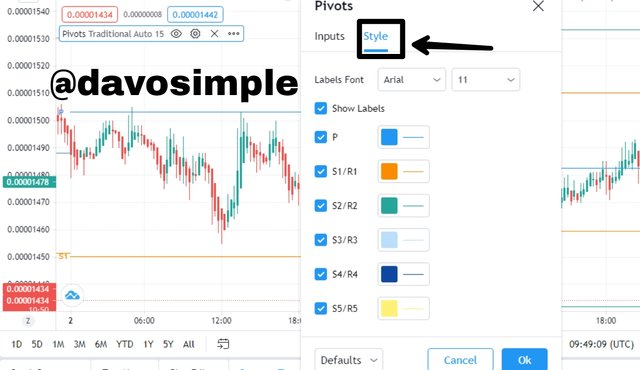
Under the settings are two categories which the configuration are embedded. The first is the Input and the second is the Style.
By Default, the input is configured to have the;
Type as Traditional
Allowed to Show Historical Pivots
Pivots Timeframe as Auto
Number of Pivots Back as 15
The style allows me to chose the number of Resistance and Support level I want to display on the chart. And also, to I can also chose different color for the Resistance levels, another different color for the Main pivot level and also another color for the Support levels.

How Pivot Point Work
From the thumb rule I earlier mentioned, whenever the price of an asset is above the main pivot point level, it is interpreted that the market is going bullish but when whenever the price of an asset is below the main pivot point level, it means that the market is boing bearish. Pivot point indicators are technically known to be in a constant for 24 hours. This indicator has been a guide for traders, helping them to know when to take profit and when to set a stop loss.
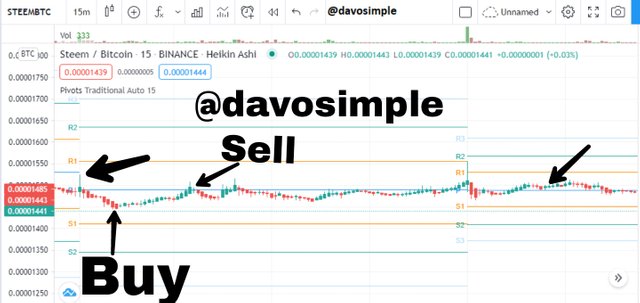
From the screenshot above, I have illustrated the market movement of the STEEM/BTC pair using pivot point. The screenshot shows a two day trading chart
The first day, the market opened with the chart going below the pivot point. The market is seen dancing on and below the pivot point level but did not cross it. If a trader is to trade during in this kind of bear market, he has to make good use of stop loss and take quick profit when the price oscillates a bit upward.
The next day, the market opened dancing a bit below the main pivot level but later crossed the main pivot level. Crossing the main pivot level means the market is going bullish. The market then remained above the main pivot level but did not break through the R1 level. In this kind of market movement, traders are not supposed to get lost in fuzz but should still employ their stop loss while taking profits when due.
In summary, the screenshot above shows that pivot points are good indicators but must not be carelessly used without a stop loss.

Pivot Point Reverse Trading
From the previous lesson about reverse strategy, prof @stream4u explained that reversal is in trading is when there is a change in direction of a trend, this means that if a trend in the upward direction, at a point, changed from going upward and started going downward, that action is called reversal. In order to use the reversal strategy in trading, the support and the resistance must be employed .
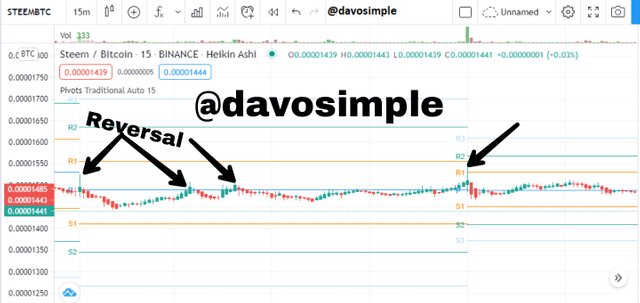
From the screenshot above, The closing of the previous day market was with a reversal. What happened there was that there was a bullish trend since the chart crossed the PP level and approached the R1 level. But it reversed back and the chart went down the PP level. Supposing a trading saw when the market was going bullish and decided to trade without making use of stop loss, he would have run into a big loss.
The new day, the market opened with the trend dancing below the PP level. This is a good buy signal for traders. But at some point, the trend wanted going bullish. At some point, the market wanted to go above the PP level, there another reversal. A trader trading during this period must always use his stop loss while taking little profits.
At the end close of the market, there was another change in direction of the trend. The trend went bullish to the point of reaching the R1 level, the market suddenly reversed and the trend went bearish again. Traders who are trading in this kind of market must ensure they employ a stop loss while taking little profits.
This therefore shows the important of using a stop loss while trading with pivot points using the reverse strategy because the indicator itself is never always 100% honest.

Mistakes In Trading With Pivot Points
Getting loss in the Fuzz: Most times, when traders see how the market is going bull and they make so much profit, they suddenly get lost in the fuzz because of greed and continue trading. At a point, when the market starts going bear, they lose almost everything.
No Plan: Most traders enter into the trading market without planning on when to enter and when to exit. They actually give all their trust to the pivot point indicator, believing that the indicator will always hold true everytime.
Ineffective use of Stop Loss: It is one thing to predict the price of the market, it is another thing for the market to hold true to the prediction. Most traders, after analysing and predicting the market, they believe the market will always obey their prediction, hence, they ignore setting their support and resistance, that is stop loss.
Greed: Most traders always want to gain big profit when they are trading. That is why they end up losing everything before the close of the market.

Pros Of Pivot Points
They help a trader to know when to enter and when to exit the market
Pivot point helps the trader to know previous day high and low. This will always help the trader in planning for the new day trading.
Pivot point helps the trader so well when using the reverse strategy while trading.
Pivot point is very easy to understand. Even new traders can understand it very quick.

Applying Pivot Point In todays Chart
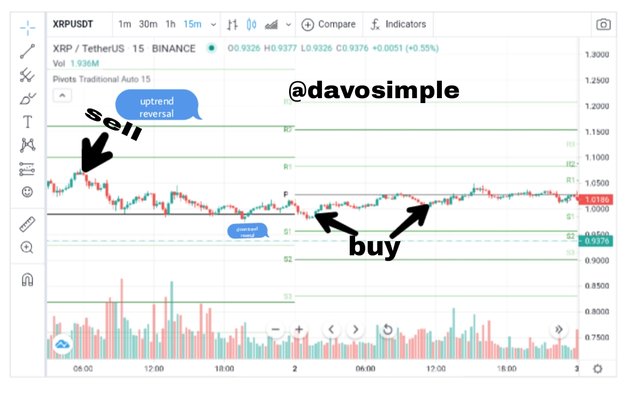
On the first day bullish market market opened with a price of $1.100. At that point, the market started going bearish. But at a point , there was very sharp reversal which made the market go bullish again. Trading in this kind of market, a trader has to be very cautious, using a stop loss on every move he makes.
Throughout that day as seen I the chart, the market is seen oscillating above the PP level and below the R1 level.
The next day, the market opened with a bearish trend. It is a good buying signal for traders. But in the middle of the day, the market moved above the PP level and immediately went down again below the PP level. Stop loss should no be ignored in this kind of market.
Prediction for the next day...
Since the last two days the market has been in the bear region, the next day, the market will like still be oscillating below the PP Level but from the fourth and fifth day, the market will start going above the PP level which will be a good time for traders to sell.

Weekly Price Prediction Of XRP
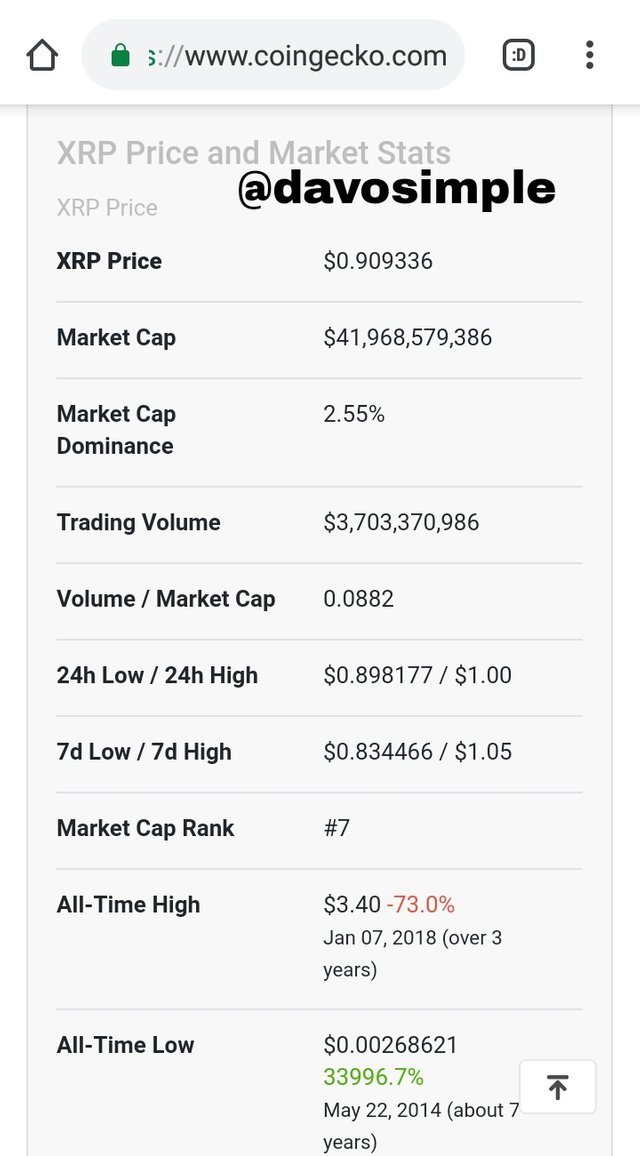
XRP is ranked #7 in the coin market at a current price of $0.9, market cap of $41,968,579,386 and a trading volume of $3,703,370,986. See screenshot above for more market stats of XRP.
I chose XRP because of the scalability and speed it uses to complete a transaction.
XRP is one of the best exchange mechanism between fiat and crypto currencies and this alone is creating bringing in more investors into the XRP blockchain.
XRP keeps making waves everyday.
I will be using MACD to support Pivot Point and then predict the price of XRP for the next one week
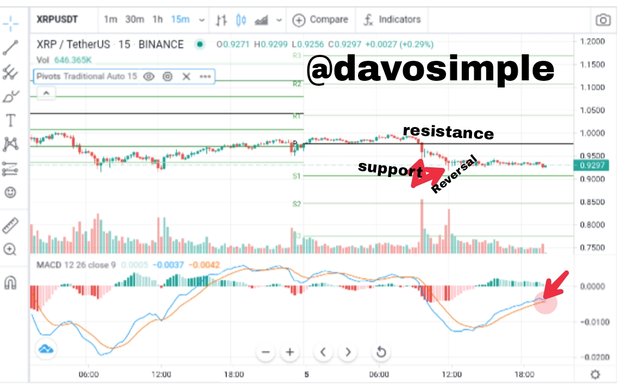
From the screenshot above, low volatility really occurred in the previous day. After some time, during the middle the day, the trend started moving above the PP level.
Notice very well that the MACD is somehow moving in accordance to the pivot point thumb rule. So as the trend goes below the PP level, the MACD line also goes below the signal line.
My prediction now is this; Looking at the MACD line, it tends to be going towards the downward direction which will mean that when it crosses the signal line and goes towards the downward direction, then the market will be seen to be bearish.
So in the next one week, 3 days, XRP will be witnessing some bear but before one week is over, XRP will experience a spike and it will go bullish.
Conclusion
Pivot point is an indicator. It doesn't mean it is 100% accurate when trading. It is just a guide that helps traders in some ways. It is always best to set stop loss while trading with pivot points.
Thank you.
Hi @davosimple
Thank you for joining The Steemit Crypto Academy Courses and participated in the Homework Task.
Your Homework Task verification has been done by @Stream4u, hope you have enjoyed and learned something new.
Thank You.
@stream4u
Crypto Professors : Steemit Crypto Academy
#affable
Downvoting a post can decrease pending rewards and make it less visible. Common reasons:
Submit
Downvoting a post can decrease pending rewards and make it less visible. Common reasons:
Submit
Downvoting a post can decrease pending rewards and make it less visible. Common reasons:
Submit